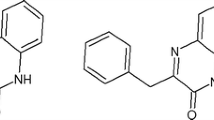Summary
The electronic absorption spectra of 2-hydroxy-1,4-naphthoquinone (HNQ) in one- and two-component solvents are discussed. The visible absorption of this reagent has been shown to arise from a charge-transfer transition of the zwitterionic tautomer stabilized by a hydrogen bond donating solvent. The formation constant of the 1:1 hydrogen bonded complex with methanol, ethanol, andn-propanol has been determined at 25 °C from the spectral behaviour in mixed solvents. The tautomerization equilibrium ofHNQ in aqueous ethanol is demonstrated and characterized. The dependence of the absorbance maximum ofHNQ on the hydrogen bond donor ability of the solvent in the visible spectrum, as measured by theTaft-Kamlet α parameter, has been established. Experimentally derived evidence is supplied to justify the recommendation ofHNQ as a novel probe for hydrogen bond donor ability in pure solvents and in mixed aqueous solvents.
Zusammenfassung
Die Absorptionsspektren von 2-Hydroxy-1,4-naphthochion (HNQ) in Ein- und Zweikomponentensystemen werden diskutiert. Die Absorption im sichtbaren Bereich stammt von einemcharge-transfer — Übergang des zwitterionischen Tautomers, das über Wasserstoffbrückenbindungen zum Lösungsmittel stabilisiert wird. Die Bildungskonstanten der binären Komplexe mit Methanol, Ethanol undn-Propanol wurden aus spektroskopischen Daten in Lösungsmittelgemischen bei 25 °C emittelt. Das Tautomeriegleichgewicht vonHNQ in wäßrigem Ethanol wird iskutiert. Die Abhängigkeit des Absorptionsmaximums vonHNQ vond der Wasserstoffbrückenbindungsbildungsfähigkeit des Lösungsmittels wird mittels desT aft-Kamlet — Parameters α beschrieben. Experimentelle Ergebnisse ermutigen zur Verwendung vonHNQ als neue Testsubstanzfür die Wasserstoffbrückenbindungsbildungsfähigkeit von reinen und gemischten Lösungsmitteln.
Similar content being viewed by others
References
Kamlet M, Taft R (1976) J Am Chem Soc98: 377
Dimroth K, Reichardt C, Siepmann T, Bohlmann F (1963) Ann Chem661: 1
Kosower E (1958) J Am Chem Soc80: 3253
Mayer U, Gerger W, Gutmann V (1977) Montash Chem108: 489
Kamlet MJ, Abboud JM, Taft RW (1977) J Am Chem Soc99: 6027
Kamlet MJ, Hall TN, Boykin J, Taft RW (1979) J Org Chem44: 2599
Kolling O (1981) Anal Chem53: 54
Marcus Y (1991) J Solution Chem20: 929
Taft R, Kamlet M (1976) J Am Chem Soc98: 2886
Baba H, Suzuki S (1961) J Chem Phys35: 1118
Issa RM, Ghoneim MM, Idriss KA, Harfoush AA (1975) Phys Chem (Neve Folge)94: 135
El-Ezaby MS, Salem TM, Zewail AH, Issa RM (1970) J Chem Soc (b): 1293
Johnston GD, Bowen RE (1965) J Am Chem Soc87: 1955
Idriss KA, Sedaira H, Hashem EY (in course of publication)
Elguero J, Marzin C, Katritzky A, Linda P (1976) The tautomerism of heterocycles. Academic Press, London, p 20
Saleh M, Idriss KA, Abu-Bakr M, Hashem E (1992) Analyst117: 1003
Kamlet M, Abboud J, Abraham M, Taft R (1983) J Org Chem98: 2877
Taft R, Abboud J, Kamlt M (1981) J Am Chem Soc103: 1080
Figueras J (1971) J Am Chem Soc93: 3255
Schnieder H, Migron Y, Marcus Y (1992) Z Phys Chem175: 145
Schneider H, Badrich Y, Migron Y, Marcus Y (1992) Z Phys Chem177: 143
Marcus Y, Migron Y (1991) J Chem Soc Faraday Trans87: 1339
Marcus Y, Migron Y (1991) J Phys Chem95: 400
Author information
Authors and Affiliations
Rights and permissions
About this article
Cite this article
Idriss, K.A., Sedaira, H., Hashem, E.Y. et al. The visible absorbance maximum of 2-hydroxy-1,4-naphthoquinone as a novel probe for the hydrogen bond donor abilities of solvents and solvent mixtures. Monatsh Chem 127, 29–42 (1996). https://doi.org/10.1007/BF00807406
Received:
Accepted:
Issue Date:
DOI: https://doi.org/10.1007/BF00807406




